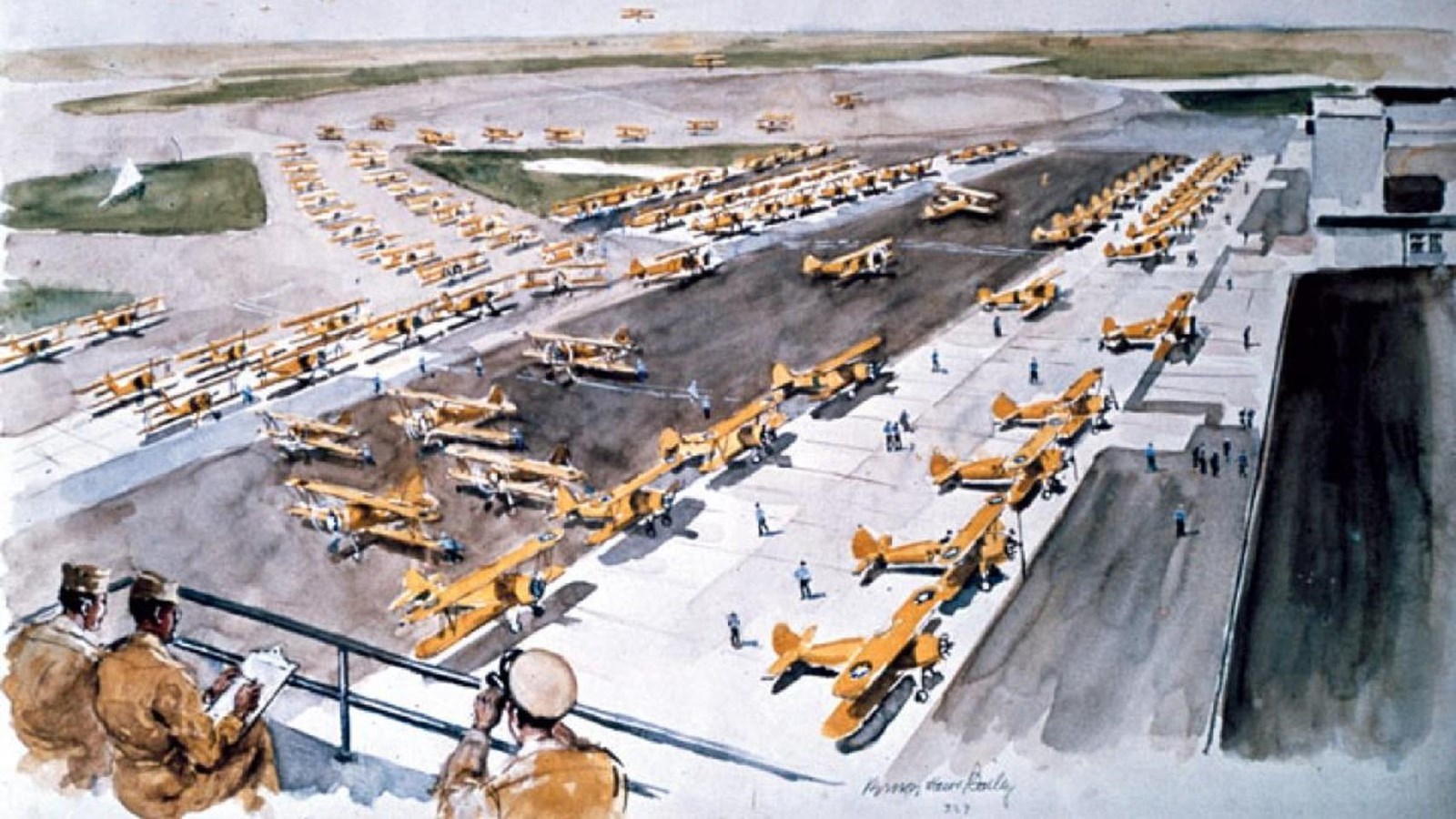Last updated: November 10, 2023
Place
South Texas Coastal Bend Area & Corpus Christi, Texas

Vernon Howe, US Navy Art Collection
American World War II Heritage City
The Texas Coastal Cities of Corpus Christi, Aransas Pass, Port Aransas, Kingsville, and Beeville within Nueces & Kleberg counties played a significant role in the World War II effort on the home front. The Naval Air Station of Corpus Christi, proclaimed as the “University of the Air” by its first commanding officer Capt. Alva Bernhard, had a main station and six auxiliary stations in the Coastal Bend. At the time of completion, Naval Air Station Corpus Christi was the largest naval training facility in the world. Commissioned on March 12, 1941, the naval air station graduated over 35,000 student pilots during World War II. Cadets who later became notable pilots during the war included future President George H. W. Bush, and future astronaut and Senator John Glenn.
Trainees came from Canada, England, Mexico, Peru, Chile, Argentina, and Bolivia. Women Accepted for Volunteer Emergency Service (W.A.V.E.S.) served at the station and its auxiliary fields as link trainer instructors, pressure chamber technicians, air traffic controllers and gunnery instructors. In addition, auxiliary airfields were added at Rodd Field (primary flight training), Cabaniss and Cuddihy (intermediate flight training), Kingsville (advanced flight training, fighters, and dive bombers), Waldron (torpedo bombers) and Chase Field in Beeville (specializing in instrument flying). Twenty-five additional outlying practice landing fields dotted the surrounding countryside. At the end of the war, the U.S. Army established a camp for German prisoners of war at Naval Air Station Corpus Christi.
The coastal bend area played a profound role in civil defense preparedness for the U.S. During the war, 20,000 civilians who enlisted with the National Youth Administration for civil defense jobs were employed at Naval Air Station Corpus Christi. They learned to service and repair Navy planes. In 1941, with World War II impending, Kingsville expanded their Red Cross to 20 departments covering all phases of work. A fund drive resulted in $3,300, the largest that had ever been collected. The Disaster Committee set up First Aid Stations and trained nurses. Kleberg-Kennedy was selected as one of six areas to have a community Auxiliary Nursing Service. Volunteers sewed and folded dressings and knit-ted garments which were sent to military stations. The Canteen Corps set up centers supervised by 85 women. A volunteer Special Services Motor Corps taught 42 women motor mechanics who were ready to serve in an emergency.
On January 6, 1946, the Corpus Christi Caller-Times provided a summary of the war bond drives, where Nueces County surpassed their quotas in each of the eight campaigns, with the most impressive between April-June 1945 when locals exceeded the $6 million goal by purchasing more than $11 million in war bonds. The final tally showed Nueces County sold more than $50 million in war bonds between 1941 and 1945.
The people of the Coastal Bend take great pride in their region’s contributions to the war effort and the preservation of World War II history. The USS Lexington Museum on the Bay, a National Historic Landmark, serves as a focal point for visitors to experience the pivotal role of aircraft carriers during the war. Additional landmarks, historical markers, parks, statues, archives, organizations, and public ceremonies honor the contributions of the Navy and the Coast Guard, the men and women who served, the local communities who supported the war effort, and those who later fought for improving conditions of veterans who encountered discrimination.
For example, the Texas Historical Commission and the Nueces County Historical Commission commemorate the heritage of Naval Air Station Corpus Christi with a series of 10+ Texas Historical Markers. The Coastal Bend State Veterans Cemetery in Corpus Christi was dedicated on December 7, 2011 (Pearl Harbor Day) and opened on Dec. 14, 2011, for burials. To date, the Coastal Bend State Veterans Cemetery has 432 World War II veterans resting on its hallowed grounds. The cemetery staff are currently working diligently to erect a monument dedicated to the military men and women served our nation during World War II.
